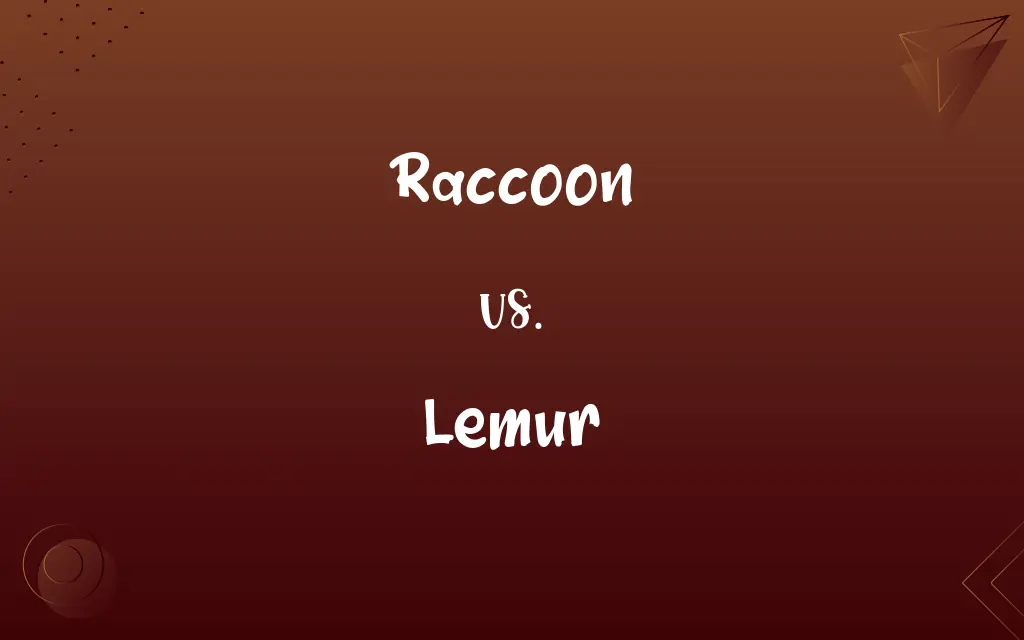Raccoon vs. Lemur: Know the Difference

By Dua Fatima & Shumaila Saeed || Published on May 4, 2024
Raccoons are adaptable, North American mammals known for their dexterous front paws and masked faces, thriving in urban areas. Lemurs, native to Madagascar, are primates with large eyes and a long tail, living in diverse social structures and habitats.

Key Differences
Raccoons, originating from North America, are omnivorous mammals recognized for their distinctive black mask and ringed tail. They are highly adaptable, able to live in both rural and urban environments, often scavenging near human dwellings. In contrast, lemurs are a group of primates found only in Madagascar, exhibiting a wide range of sizes and behaviors, but they share common traits such as large eyes adapted for nocturnal activity and long tails used for balance and communication.
Dua Fatima
May 04, 2024
While raccoons are solitary for most of the year, showing great intelligence and problem-solving skills, particularly in their search for food, lemurs live in various social structures, from the solitary to the highly social. Lemurs' social behaviors and communication are complex, involving vocalizations, scent markings, and visual signals, whereas raccoons communicate through a series of vocalizations, body postures, and facial expressions, especially when threatened or during mating seasons.
Dua Fatima
May 04, 2024
Raccoons have a broad diet that includes fruits, nuts, insects, and small animals, showcasing their opportunistic feeding habits. They are known for their dexterous front paws, which allow them to open containers and unlock doors. Lemurs, on the other hand, primarily feed on fruit, leaves, and occasionally insects, depending on the species. Some lemur species have specialized diets, like the bamboo lemur, which consumes bamboo exclusively.
Dua Fatima
May 04, 2024
Concerning conservation status, many lemur species are at risk due to habitat destruction, hunting, and the pet trade, making them one of the most endangered groups of mammals. Conservation efforts are crucial for their survival. Raccoons, however, are listed as least concern due to their adaptability and increasing population, especially in urban areas where they have few natural predators and abundant food sources.
Dua Fatima
May 04, 2024
Both raccoons and lemurs play significant roles in their ecosystems. Raccoons act as both predator and prey, controlling populations of insects and small animals while providing food for larger predators. Lemurs are important seed dispersers in Madagascar's forests, contributing to the regeneration and health of their habitats. Despite their different origins and lifestyles, both animals face challenges from human activities and environmental changes.
Shumaila Saeed
May 04, 2024
ADVERTISEMENT
Comparison Chart
Diet
Omnivorous: insects, fruits, small animals
Primarily frugivorous: fruits, leaves, insects
Dua Fatima
May 04, 2024
Social Structure
Solitary (except in mating season)
Ranges from solitary to social groups
Shumaila Saeed
May 04, 2024
Physical Traits
Black mask, ringed tail, dexterous paws
Large eyes, long tail, varied sizes
Hifza Nasir
May 04, 2024
ADVERTISEMENT
Conservation Status
Least concern, adaptable to human presence
Many species endangered due to habitat loss and hunting
Dua Fatima
May 04, 2024
Role in Ecosystem
Predator and prey, controls insect populations
Seed dispersers, contributing to forest regeneration
Shumaila Saeed
May 04, 2024
Raccoon and Lemur Definitions
Raccoon
A nocturnal mammal known for its dexterity and adaptability.
A raccoon used its front paws to open a secured trash bin.
Dua Fatima
Mar 04, 2024
Lemur
Faces threats from habitat destruction and is often endangered.
Many lemur species are endangered due to deforestation in Madagascar.
Dua Fatima
Mar 04, 2024
ADVERTISEMENT
Raccoon
Listed as least concern due to their widespread and growing population.
Raccoons have a stable population, facing few natural threats in cities.
Hifza Nasir
Mar 04, 2024
Lemur
Engages in complex social structures and communication.
Lemurs in a troop communicate using a variety of vocalizations and scents.
Hifza Nasir
Mar 04, 2024
Raccoon
Solitary except during breeding, known for its problem-solving skills.
A solitary raccoon solved a complex puzzle to access food.
Dua Fatima
Mar 04, 2024
Lemur
A primate endemic to Madagascar, with diverse species and sizes.
The ring-tailed lemur is recognized by its long, striped tail.
Dua Fatima
Mar 04, 2024
Raccoon
Omnivorous, feeding on a wide range of urban and wild foods.
The raccoon foraged for fruits and insects in the forest edge.
Dua Fatima
Mar 04, 2024
Lemur
Mostly nocturnal, with large eyes adapted for night vision.
Nocturnal lemurs use their large eyes to navigate the dark forests.
Dua Fatima
Mar 04, 2024
Raccoon
Adapts well to urban environments, thriving near human settlements.
Urban raccoons often navigate complex city landscapes to find food.
Hifza Nasir
Mar 04, 2024
Lemur
Primarily frugivorous, playing a key role in seed dispersal.
Lemurs disperse seeds throughout the forest, aiding in plant diversity.
Hifza Nasir
Mar 04, 2024
Lemur
(colloquial) Any strepsirrhine primate of the infraorder Lemuriformes, superfamily Lemuroidea, native only to Madagascar and some surrounding islands.
Dua Fatima
Mar 03, 2024
Lemur
(obsolete) A loris (Lemur tardigradus, now Loris tardigradus), predating the 10th edition of Systema Naturæ.
Dua Fatima
Mar 03, 2024
Lemur
One of a family (Lemuridæ) of nocturnal mammals allied to the monkeys, but of small size, and having a sharp and foxlike muzzle, and large eyes. They feed upon birds, insects, and fruit, and are mostly natives of Madagascar and the neighboring islands, one genus (Galago) occurring in Africa. The slow lemur or kukang of the East Indies is Nycticebus tardigradus. See Galago, Indris, and Colugo.
Dua Fatima
Mar 03, 2024
Lemur
Any of various primates of the infraorder Lemuriformes of Madagascar and adjacent islands, having elongated lower incisors and nails on all digits except the second toe of the hind foot.
Dua Fatima
Mar 03, 2024
Lemur
Any of the genus Lemur, represented by the ring-tailed lemur (Lemur catta).
Dua Fatima
Mar 03, 2024
Repeatedly Asked Queries
What is a raccoon?
A raccoon is a North American mammal known for its adaptability, distinctive masked face, and dexterous paws.
Shumaila Saeed
May 04, 2024
What is a lemur?
A lemur is a primate native to Madagascar, characterized by its large eyes, long tail, and varied social behaviors.
Shumaila Saeed
May 04, 2024
How do raccoon and lemur social structures compare?
Raccoons are mostly solitary, while lemurs can be found in solitary to highly social groupings, depending on the species.
Hifza Nasir
May 04, 2024
What are the primary differences in their diets?
Raccoons are omnivorous, eating a wide variety of foods, while lemurs primarily eat fruits and leaves, with some species having specialized diets.
Dua Fatima
May 04, 2024
How do raccoons and lemurs differ in habitat?
Raccoons are found in both urban and rural areas across North America, while lemurs inhabit forests and dry regions of Madagascar.
Dua Fatima
May 04, 2024
How are conservation efforts different for raccoons and lemurs?
Conservation efforts for lemurs focus on protecting habitats and preventing hunting, while raccoons, being less threatened, require minimal conservation actions.
Dua Fatima
May 04, 2024
Why are lemurs considered endangered?
Many lemur species face endangerment due to habitat loss, hunting, and the pet trade, impacting their survival in Madagascar.
Dua Fatima
May 04, 2024
What unique features distinguish lemurs from other primates?
Lemurs are notable for their large eyes, nocturnal habits, and diverse social structures, unique to Madagascar's isolated environment.
Hifza Nasir
May 04, 2024
Can raccoons live in urban environments?
Yes, raccoons are highly adaptable and can thrive in urban settings, often seen scavenging for food in cities.
Dua Fatima
May 04, 2024
What roles do raccoons play in their ecosystems?
Raccoons help control insect and small animal populations, serving as both predator and prey in their environments.
Shumaila Saeed
May 04, 2024
Share this page
Link for your blog / website
HTML
Link to share via messenger
About Author
Written by
Dua FatimaCo-written by
Shumaila SaeedShumaila Saeed, an expert content creator with 6 years of experience, specializes in distilling complex topics into easily digestible comparisons, shining a light on the nuances that both inform and educate readers with clarity and accuracy.

































































